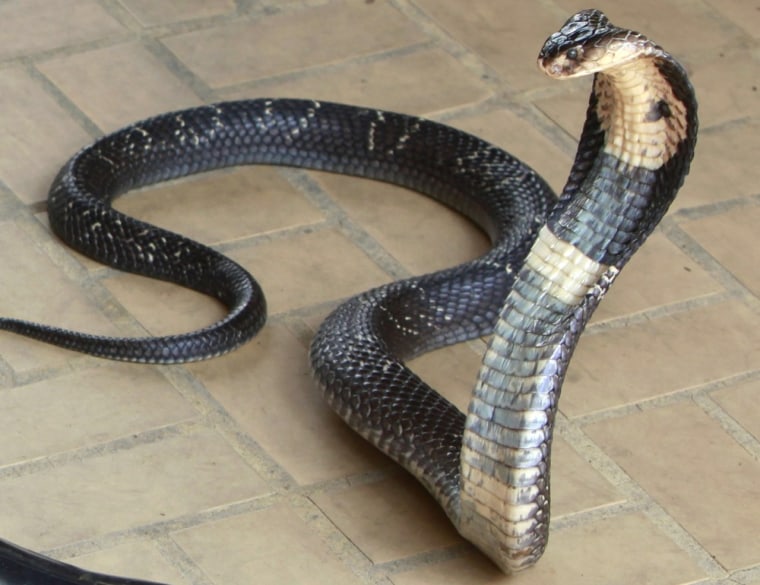Treating a paralyzing snakebite could one day be as easy as sniffing a nasal spray, according to a California researcher who hopes to curb bite-related deaths that claim as many as 125,000 people worldwide each year.
Dr. Matt Lewin, an expedition medicine expert with the University of California, San Francisco, says he has hit on a way to produce a cheap, portable first-aid snakebite treatment that could change the way travelers and residents of third-world countries respond to the venomous threat.
"Just get rid of the needles," said Lewin, the director of the Center for Exploration and Travel Health at the California Academy of Sciences.
Instead of grappling with cumbersome syringes and complicated directions, an unfortunate snakebite victim could sniff a drug called neostigmine, which already is recommended for use intravenously to treat paralyzing bites.
The research is in its very early stages, but Lewin has put out a paper that describes an experiment with a single volunteer, a 45-year-old man who agreed to be chemically paralyzed – and then take the antidote. Twenty minutes later, the deadly symptoms were reversed, the paper reports.
“You only need a few milligrams of the drug to forestall the immediately life-threatening consequences of a snakebite that causes paralysis,” said Lewin, whose study is detailed this week in the latest issue of the journal Clinical Case Reports.
Last month, one of Lewin's colleagues, Dr. Stephen Samuel of Trinity College in Dublin, used the method to treat a woman in India whose face was paralyzed by a krait, a deadly snake in a country where an estimated 1 million people are bitten every year.
"India is the snakebite capital of the world," Lewin said. Globally, as many as 5.5 million snakebites might occur annually, according to a 2008 study.
The woman already had undergone a full course of antivenom treatment, but it was only after receiving a neostigmine nasal spray that her paralysis was reversed – within 30 minutes.
“Two weeks after being treated, the patient reported having returned to her daily activities,” Lewin reported.
Lewin came up with the idea for the nasal spray after preparing for a trip to a snake-ridden part of the Philippines and realizing that neither he nor his companions had a good way to treat paralyzing snakebite in the wild.
More than a decade ago, Joe Slowinski, a renowned herpetologist at the California Academy of Sciences, died after being bitten by a banded krait while doing research in Myanmar, where emergency medical care was not available.
Antivenoms have been the only solution to paralyzing snakebite, but they pose several problems, Lewin said. They’re expensive, they require refrigeration and they need needles and syringes to administer. The dosing can be tricky and some people have bad reactions to the drugs.
“I thought, ‘There’s gotta be a better way to do this,’” said Lewin. “So I started trying to rethink the problem."
He recalled that neostigmine is the World Health Organization’s recommended drug for treating snakebite, albeit in IV form. And he also remembered that the drug has been used in nasal sprays to treat myasthenia gravis, a neuromuscular disease.
So Lewin mixed up a recipe of the nasal spray and began planning his experiment. He agrees that it was an unusual way to test a new drug, but Lewin insists that the required institutional review board signed off on the plan. He won’t identify the volunteer for privacy reasons, but says the man trusted the experiment implicitly.
The volunteer was given a drug, mivacurium, that Lewin said mimics the neurotoxic effects of envenomation, from weakened eyelids to the beginnings of respiratory distress that can lead to death. Before it got that far, he was treated with the neostigmine nasal spray.
The successful experiment has garnered Lewin new supporters – and new funding – to pursue more traditional research, including drug trials in mice. He hopes to test the product in India, perhaps in a clinical trial that could be in place by the beginning of the next monsoon season – the worst time for snakebites – starting next May.
Other snakebite experts say that Lewin’s goal is admirable, but it will take much more research to ensure that any snakebite nasal spray is safe and effective. Dr. Richard Clark, director of the division of medical toxicology at the University of California San Diego Health System, said that the drug may help with muscular paralysis, but not with the devastating effects on blood clotting and tissue destruction that snakebite also causes.
“I think it’s worth trying, but I don’t think it’s going to reduce mortality,” Clark said.
If it works out, Lewin envisions a world where neostigmine and other drugs could be administered nasally to blunt the effects of snakebite. It might have limited use in the U.S., where 8,000 people suffer bites each year, but only coral snakes harbor paralyzing venom.
But nasal spray made from neostigmine, which is cheap and widely available, could be a huge boon in places like India, Lewin said. There, 75 percent of people who die from snakebite do so outside of hospitals, usually because of long travel delays.
The spray wouldn’t replace antivenom, but it could buy victims more time, he predicted.
“The best potential for the drug is to forestall an incipient catastrophe,” Lewin said.
JoNel Aleccia is a senior health writer with NBC News. You can reach her on Twitter at @JoNel_Aleccia or send her an email.
